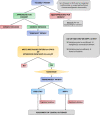High continuous positive airway pressures versus non-invasive positive pressure ventilation in preterm neonates: protocol for a multicentre pilot randomised controlled trial
- PMID: 36787974
- PMCID: PMC9930542
- DOI: 10.1136/bmjopen-2022-069024
High continuous positive airway pressures versus non-invasive positive pressure ventilation in preterm neonates: protocol for a multicentre pilot randomised controlled trial
Abstract
Introduction: Low pressure nasal continuous positive airway pressure (nCPAP) has long been the mainstay of non-invasive respiratory support for preterm neonates, at a constant distending pressure of 5-8 cmH2O. When traditional nCPAP pressures are insufficient, other modes including nasal intermittent positive pressure ventilation (NIPPV) are used. In recent years, high nCPAP pressures (≥9 cmH2O) have also emerged as an alternative. However, the comparative benefits and risks of these modalities remain unknown.
Methods and analysis: In this multicentre pilot randomised controlled trial, infants <29 weeks' gestational age (GA) who either: (A) fail treatment with traditional nCPAP or (B) being extubated from invasive mechanical ventilation with mean airway pressure ≥10 cmH2O, will be randomised to receive either high nCPAP (positive end-expiratory pressure 9-15 cmH2O) or NIPPV (target mean Paw 9-15 cmH2O). Primary outcome is feasibility of the conduct of a larger, definitive trial as assessed by rates of recruitment and protocol violations. The main secondary outcome is failure of assigned treatment within 7 days postrandomisation. Multiple other clinical outcomes including bronchopulmonary dysplasia will be ascertained. All randomised participants will be analysed using intention to treat. Baseline and demographic variables as well as outcomes will be summarised and compared using univariate analyses, and a p<0.05 will be considered significant.
Ethics and dissemination: The trial has been approved by the respective research ethics boards at each institution (McMaster Children's Hospital: Hamilton integrated REB approval #2113; Royal Alexandra Hospital: Health Research Ethics Board approval ID Pro00090244; Westmead Hospital: Human Research Ethics Committee approval ID 2022/ETH01343). Written, informed consent will be obtained from all parents/guardians prior to study enrolment. The findings of this pilot study will be disseminated via presentations at national and international conferences and via publication in a peer-reviewed journal. Social media platforms including Twitter will also be used to generate awareness.
Trial registration number: NCT03512158.
Keywords: EPIDEMIOLOGY; NEONATOLOGY; RESPIRATORY MEDICINE (see Thoracic Medicine).
© Author(s) (or their employer(s)) 2023. Re-use permitted under CC BY-NC. No commercial re-use. See rights and permissions. Published by BMJ.
Conflict of interest statement
Competing interests: None declared.

